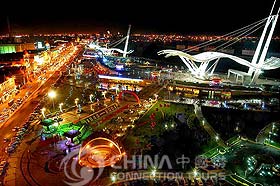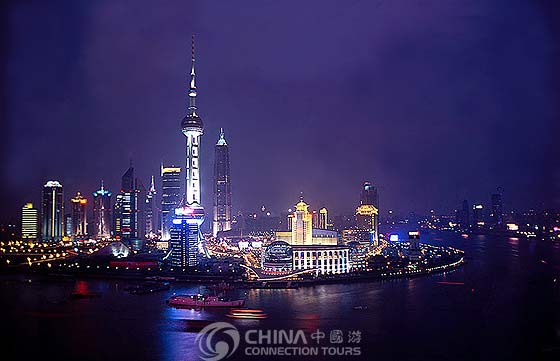 Tianjin, which means "Heavenly Port to the Capital," is 87 miles southeast of Beijing, on the coast of the Bohai Sea. As China's third-largest city, it is one of the four municipalities directly controlled by the central government. Its location at the confluence of five tributaries of the Haihe River, as well as at the junction of the Beijing-Shanhaiguan and Beijing-Shanghai railways, makes it a hub of convenient land and water transportation.
Tianjin, which means "Heavenly Port to the Capital," is 87 miles southeast of Beijing, on the coast of the Bohai Sea. As China's third-largest city, it is one of the four municipalities directly controlled by the central government. Its location at the confluence of five tributaries of the Haihe River, as well as at the junction of the Beijing-Shanhaiguan and Beijing-Shanghai railways, makes it a hub of convenient land and water transportation.
Geographical Features
The municipality is 189 km long from north to south and 117 km wide from east to west with a total land area of 11,920 km. There are 5 counties and 13 districts outside the city proper. Tianjin has 153 km of coastline. Tianjin lies on the northeast edge of the North China plain, on the lower reaches of the Haihe River where its five main tributaries join to run into the sea. To the east is the Bohai Sea, to the north the Yanshan Mountains. Beijing lies 120 km to its west.
In times past, Tianjin was an important garrison for the defense of the capital. Its location has a distinct advantage, being at the center of the fertile and productive northern coastline and serving as the nearest sea access for North China. It is the largest year-round facility port in North China with the largest container piers in the country; it has trade links with over 300 ports in 170 countries. It is also the largest freight transport center in northern China. In 1991, Tianjin became one of the easternmost starting points of the Euro-Asian Land Bridge.
Topographically speaking, the Tianjin municipal area has mountains, hills, plains and coastal zones. The land slopes downward from north to south and west to east. Mountainous areas cover 651 square km, or 6% of the municipal area. The highest hill is only 200 meters high. Most of the municipality is on the plain, which stretches for 10,664 square km and comprises 94% of the area.
Situated on the eastern edge of the Euro-Asian continent, Tianjin has four distinct seasons. It enjoys a mix of continental and maritime climates, though the monsoons cause sharp temperature differences. Winters are cold, dry and windy; summers are hot, rainy and the wind blows from the south. Annual average temperatures do not drop below 11 degrees Celsius. There are about 190 frost-free days. Annual rainfall is around 600 mm.
Over 45% of the total land is cultivated; inhabited and industrial areas account for 18%; transportation networks 3%; lakes, rivers and canals 26%. Along the coast, there are 120 square km of dunes and empty land awaiting development—ideal locations for developing the petrochemical and marine chemical industries.
 Over 30 different kinds of ferrous and non-ferrous minerals, fuels and geothermal deposits have been found in this region. Over 10 different ferrous minerals have been identified (gold, manganese, copper, tin, iron, molybdenum, tungsten, etc.); non-ferrous deposits include marble and limestone. Petroleum deposits are estimated at 450 million tons, and natural gas at 140 billion cubic meters. Tianjin has mineral-rich underground hot springs.
Over 30 different kinds of ferrous and non-ferrous minerals, fuels and geothermal deposits have been found in this region. Over 10 different ferrous minerals have been identified (gold, manganese, copper, tin, iron, molybdenum, tungsten, etc.); non-ferrous deposits include marble and limestone. Petroleum deposits are estimated at 450 million tons, and natural gas at 140 billion cubic meters. Tianjin has mineral-rich underground hot springs.
The region's main natural resources are marine salt, petroleum and fish. China's largest salt production center is located here with an annual output of over 2 million tons. Rich underwater deposits of petroleum and natural gas are located in the Bohai Sea, extensions of the Shengli, Dagang and Liaohe oil fields in the North China Basin. Marine life is plentiful along the coastline with over 70 different kinds of fish. Situated at the mouth of the Haihe River, the area is crisscrossed by streams and channels that support a variety of fresh water fish.
The city flower is the Chinese Rose and city bird is the Seagull.
People
The city boosts a permanent population of 10.4 million people. The largest minority population in the city is Muslim.
History
Early settlement in the Tianjin region dates back to the Warring States period, but Tianjin's later prominence was primarily tied to the rise of nearby Beijing as the capital of northern nomadic dynasties and later of the country as a whole. The recorded history of the city began with the excavation of the Grand Canal in the Sui dynasty (581-618 AD). Tianjin became important in the 14th century, when grain, carried to Beijing along the Grand Canal that runs from the North to the South, was stored there. In the late Tang dynasty (618-907), Tianjin became a major land and sea port for the transport of southern rice and silk to the north. During the Song (960-1279 and Yuan dynasties (1271-1368), Tianjin was an important military garrison and grain shipment center. It was enclosed by walls in the 15th century and enjoyed remarkable prosperity during the Ming and Qing dynasties.
The city suffered severe demolition during the Yihetuan Uprising (Boxer Rebellion) in 1900. After Tianjin was captured, the European invaders tore down the walls to make sure that Tianjin could never again be used as a rebel sanctuary. As a result of the Peking Treaty signed in the wake of the Second Opium War, Tianjin became an open port for foreign trade with concession areas earmarked for colonial residents of various countries, thus establishing distinctive architectural styles in the riverside areas: English Victorian, Roman style streets, French chateaux, and German Bavarian villas. During those chaotic years, Tianjin was one of the first Chinese cities to set up a fledging modern industry.
After several decades of development, Tianjin is now one of China's leading manufacturing and commercial centers. Its industrial production and trade volumes place it second after Shanghai. It is the largest financial and trading center in North China. In 1931, there were over 17,000 businesses in the city, with 4,000 in modern machine making and handicrafts. Its exports accounted for 25% of the national total. After 1949, the city expanded to 61 square km with a population of 1.79 million. After a number of administrative adjustments, it finally took on its present form in 1973.
Today the city is nicknamed the "Shanghai of the North," a reference to its history as a foreign concession, its heavy industrial output, its large port and European architecture. Like Beijing, Tianjin is a large, sprawling municipality of which most is rural. Thanks to its history, Tianjin has encountered many European cultures. Their integration into Chinese society has made Tianjin's urban culture uniquely diverse.

